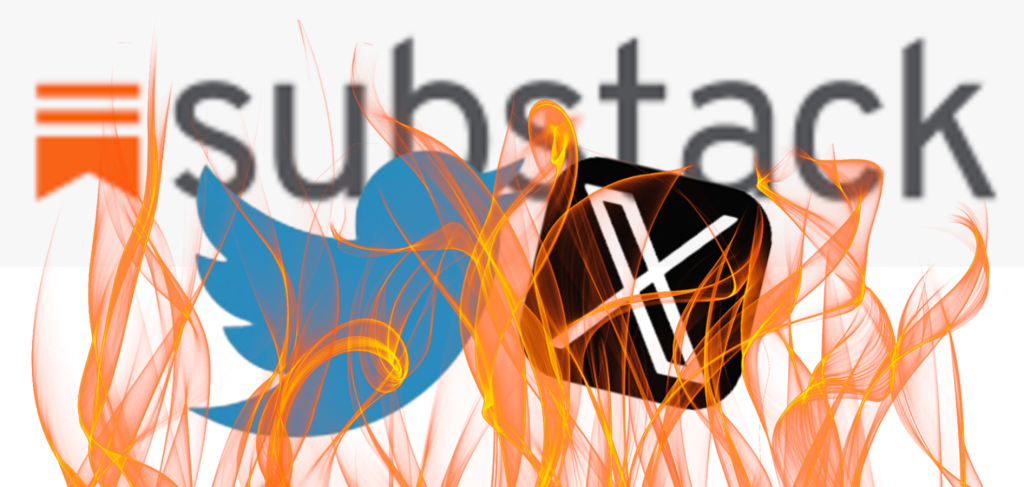And it’ll be worse this time around!

The writing life, which has never exactly been a picnic for independent journalists and freelancers, became a lot harder in the wake of Elon Musk’s takeover of Twitter in late 2022.
After a year of watching the platform’s slow-motion implosion, I covered the impact of its loss for DAME mag:
Twitter’s degradation is already having significant consequences not only for highly clouted super-users with millions of followers, but for what I think of as the “workhorses” of the platform. People like me: the writers, academics, journalists, and content creators who once camped out on the app most days following the news, the jokes, and the general conversation …
… For folks who once relied on Twitter to interact with colleagues and neighbors, who used the app as an essential public square where anyone could be heard, even if they didn’t have institutional backing or the all-important “clout,” the loss of Twitter as a meaningful social tool has meant a loss of income, opportunities, and precious social and professional connections.
And we’re being set up for it to happen all over again, this time on Substack.
New reporting from The Wrap details how Substack’s decision to implement a new “follow” feature — part of its transition from newsletter publishing platform to social media site — has tanked subscription growth for lots of newsletter writers:
“Substack is completely gutting their business right now,” author Jeanna Kadlec wrote on Threads. “Every writer I know is seeing our subscriptions plummet as our ‘follower’ count rises.”
“This latest intervention is indicative of their efforts to transition to a social media hub where they can sell ad space,” Kadlec continued.
Essentially, the “follow” feature allows Substack to hold writers (and readers) hostage on their platform, forcing them to operate in a closed-content ecosystem that predominantly benefits Substack. Readers must use the Substack app or the Substack site to see content from writers they “follow,” and writers have no way of independently reaching their “followers” — whereas they can email their subscribers directly, or, if they transition to another platform, can bring those subscribers with them.

Audience portability is a massive benefit for writers. It’s an essential part of an independent publisher’s total compensation package, along with the literal money (some of us) get from paying readers. Indeed, free subscribers’ data — especially their emails — can be as or more valuable than the few cents or dollars we get per post from our paid subscribers. Independent publishing is as much about eyeballs as it is about dollars. For example: when it’s time to go looking for an agent or pitch a book, part of what a writer is selling to a potential rep or publisher is their audience reach. Substack is ensuring writers don’t have full access to that information.
And Substack absolutely understands the importance of eyeballs, which is why it’s now set itself up to get both “follower” and “subscriber” data that it can monetize via ads or anything else, at writers’ expense. Now, Substack writers only have access to their subscriber lists — not their follower lists.
Follower number go up. Subscriber number go down. Good for Substack. Bad for writers.
As long as Substack exists, this will probably be fine, inasmuch as people who publish there do not mind the 10% cut that Substack takes from their paid subscriptions and redistributes to support and retain the right-wing writers and content behind many of the platform’s highest-earning newsletters.
But when Substack tanks — and I think its right-wing, Musk-flavored, tech-bro-brained management indicates that it will — it won’t just mean losing the audience for our 280-character late-night gummy jokes and covfefe memes. It won’t just mean losing a huge community of colleagues and readers. It will mean losing a substantial portion of the audience for content that takes a hell of a lot more effort to produce — the thoughtful rants, the reported deep-dives, the serial fiction, the smart criticism. And without access to “follower” lists and emails, there will be no way to find them again. Writers will, once again, have to rebuild from near-scratch elsewhere.
Just like we’re doing now with the loss of Twitter.
And Substack’s inevitable downfall will be the Twitter implosion plus an order of magnitude, because while Twitter was an important component of audience cultivation and community for independent publishers, it was not itself a funding platform.
Substack already makes it difficult for writers who leave the platform to tote our paid subscribers elsewhere. As an example: Substack scares anyone who starts the process of migrating paid subscribers to a new platform into believing that they have to pay out their remaining subscriptions to Substack before they’re able to move, which could, for mid- and high-grossing writers, mean cutting a four- or even five-figure check. But if you’re simply moving platforms and you intend to provide the same paid content elsewhere, you can transition your paid subscribers to the new spot. But only if you say the magic words to Substack to get them to disconnect from your Stripe payment account, or else they’ll automatically continue to take 10% of your paid subs even if you move.
Garbage Day posted through it:
After leaving Substack, I luckily happened to come across some documentation from Ghost and a great post by writer Molly White about how you have to personally ask Substack’s support team to remove their access to your Stripe account. If you don’t, they can still take their 10% cut from your subscriptions, even though you’re no longer using them as a host. Which is ridiculous and, frankly, predatory, considering Substack, itself, does not mention this anywhere.
In light of this, I’m not super optimistic about what will happen to Substack content, subscriber lists, and paid subscriptions if and when the platform implodes or transitions fully to its social media model or decides to turn itself into something else entirely.
This post is already long enough, so I won’t go into detail about Substack alternatives, though they are plentiful and range from free and cheap to very pricey, and from low/no-lift to maximum bells and whistles. I chose WordPress because its longevity as a publishing platform is well established, but I know newsletterers who are very happy with their new homes on Beehiiv, Ghost and Buttondown.
Ultimately, I think writers should leave Substack because it’s a haven for Nazi and fascist ideologies. But if that’s not enough to motivate folks to stop publishing there, I can only hope that the prospect of losing access to their audiences at the merest whim of a Silicon Valley tech bro lights a fire under some asses to move to a platform where they are more likely to to have full ownership of everything they’re entitled to as independent publishers.
Thanks for reading Home with the Armadillo! To get the latest posts in your inbox, subscribe below. And if you like what you read, consider dropping a few bucks in my tip jar.





Leave a comment